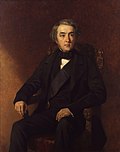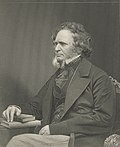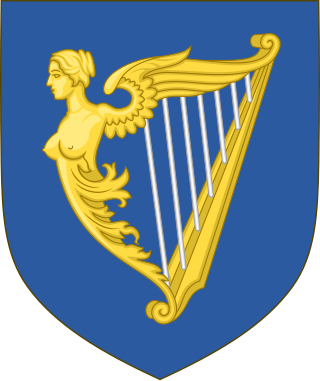Chief Secretary for Ireland
Important political office in the British administration of Ireland (1566–1922) From Wikipedia, the free encyclopedia
The Chief Secretary for Ireland was a key political office in the British administration in Ireland. Nominally subordinate to the Lord Lieutenant, and officially the "Chief Secretary to the Lord Lieutenant",[1] from the early 19th century until the end of British rule he was effectively the government minister with responsibility for governing Ireland, roughly equivalent to the role of a Secretary of State, such as the similar role of Secretary of State for Scotland. Usually it was the Chief Secretary, rather than the Lord Lieutenant, who sat in the British Cabinet.[2] The Chief Secretary was ex officio President of the Local Government Board for Ireland from its creation in 1872.[3]
This article needs additional citations for verification. (March 2011) |
| Chief Secretary for Ireland | |
|---|---|
 Arms of the Kingdom of Ireland | |
| Style | The Right Honourable as a member of the Privy Council |
| Residence | Chief Secretary's Lodge (from 1776) |
| Appointer | The Lord Lieutenant |
| Term length | At the pleasure of the Lord Lieutenant |
| Inaugural holder | Edward Waterhouse |
| Formation | 20 January 1566 |
| Final holder | Sir Hamar Greenwood |
| Abolished | 19 October 1922 |

The Chief Secretary's residence was the Chief Secretary's Lodge in the Phoenix Park, next to the Viceregal Lodge.
British rule over much of Ireland came to an end as the result of the Irish War of Independence, which culminated in the establishment of the Irish Free State. In consequence the office of Chief Secretary was abolished, as well as that of Lord Lieutenant. Executive responsibility within the Irish Free State and Northern Ireland was effectively transferred to the President of the Executive Council (i.e. the prime minister) and the Prime Minister of Northern Ireland respectively.
History of the office
Summarize
Perspective

The dominant position of the Lord Lieutenant at Dublin Castle had been central to the British administration of the Kingdom of Ireland for much of its history. Poynings' Law in particular meant that the Parliament of Ireland lacked an independent power of legislation, and the Crown kept control of executive authority in the hands of the Lord Lieutenant and its own appointees, rather than in the hands of ministers responsible to the Irish parliament.
In 1560, Queen Elizabeth I of England and Ireland ordered the Lord Lieutenant, the Earl of Sussex, to appoint John Challoner of Dublin as Secretary of State for Ireland "because at this present there is none appointed to be Clerk of our Council there, and considering how more meet it were, that in our realm there were for our honour one to be our Secretary there for the affairs of our Realm".[4] The appointment of a Secretary was intended to both improve Irish administration, and to keep the Lord Lieutenant in line.[citation needed] The role of Secretary of State for Ireland and Chief Secretary of Ireland were originally distinct positions, Thomas Pelham being the first individual appointed to both offices concurrently in 1796.[5]
Over time, the post of Chief Secretary gradually increased in importance, particularly because of his role as manager of legislative business for the Government in the Irish House of Commons, in which he sat as an MP. While the Irish administration was not responsible to the parliament, it nevertheless needed to manage and influence it in order to ensure the passage of legislation.
Chief Secretary Viscount Castlereagh played a key role in the enactment of the Act of Union which passed in the Irish Parliament on its second attempt in 1800 through the exercise of patronage and direct bribery.[citation needed] Upon the Union on 1 January 1801, the Kingdom of Ireland was merged into the United Kingdom of Great Britain and Ireland and the Irish parliament ceased to exist. However, the existing system of administration in Ireland continued broadly in place, with the offices of Lord Lieutenant and Chief Secretary retaining their respective roles.
The last Chief Secretary to represent an Irish constituency while in office was Chichester Parkinson-Fortescue, MP for County Louth, who served from 1868 to 1871.
The last Chief Secretary was Sir Hamar Greenwood, who left office in October 1922. The Irish Free State, comprising the greater part of Ireland, would become independent on 6 December 1922. In Northern Ireland, a new Government of Northern Ireland was established, with a Prime Minister of Northern Ireland. This government was suspended in 1972, and the position of Secretary of State for Northern Ireland was created as a position in the British cabinet.
List of chief secretaries for Ireland
Summarize
Perspective
This list includes holders of a key political office in the British administration in Ireland. Nominally subordinate to the Lord Lieutenant, from the late 18th century until the end of British rule he was effectively the government minister with responsibility for governing Ireland; usually it was the Chief Secretary, rather than the Lord Lieutenant, who sat in the British Cabinet.[2] Exceptions were the periods from 29 June 1895 to 8 August 1902, when the Lord Lieutenant Lord Cadogan sat in the Cabinet and the Chief Secretaries Gerald Balfour until 9 November 1900 did not sit there and George Wyndham from that date also sat there,[6] and from 28 October 1918 to 2 April 1921, when both the Lord Lieutenant Lord French and the Chief Secretaries Edward Shortt, Ian Macpherson and Sir Hamar Greenwood sat in the Cabinet.[7]
Kingdom of Ireland
United Kingdom
1801–1852 | |||||
| Name | Portrait | Term of office | Political party | ||
|---|---|---|---|---|---|
| Charles Abbot MP for Helston |
 |
1801 | 1802 | Tory | |
| William Wickham MP for Cashel |
 |
1802 | 1804 | Tory | |
| Sir Evan Nepean, Bt MP for Bridport |
 |
1804 | 1805 | Tory | |
| Nicholas Vansittart MP for Old Sarum |
 |
1805 | 1805 | Tory | |
| Charles Long MP for Wendover |
 |
1805 | 1806 | Tory | |
| William Elliot MP for Peterborough |
 |
1806 | 1807 | Whig | |
| Sir Arthur Wellesley MP for Tralee (1807) MP for Mitchell (1807) MP for Newport (1807–09) |
 |
1807 | 1809 | Tory | |
| Robert Dundas MP for Midlothian |
 |
1809 | 1809 | Tory | |
| William Wellesley-Pole MP for Queen's County |
 |
1809 | 1812 | Tory | |
| Robert Peel MP for Chippenham (1812–17) MP for Oxford University (1817–29) |
 |
1812 | 1818 | Tory | |
| Charles Grant MP for Inverness-shire |
 |
1818 | 1821 | Tory | |
| Henry Goulburn MP for West Looe (1818–26) MP for Armagh City (1826–31) |
 |
29 December 1821 | 29 April 1827 | Tory | |
| William Lamb MP for Bletchingley |
 |
29 April 1827 | 21 June 1828 | Whig | |
| Lord Francis Leveson-Gower[13] MP for Sutherland |
 |
21 June 1828 | 30 July 1830 | Tory | |
| Sir Henry Hardinge MP for St Germans |
 |
30 July 1830 | 15 November 1830 | Tory | |
| Edward Smith-Stanley MP for Windsor (1831–32) MP for North Lancashire (1832–44) |
 |
29 November 1830 | 29 March 1833 | Whig | |
| Sir John Hobhouse, Bt MP for Westminster |
 |
29 March 1833 | May 1833 | Whig | |
| Edward Littleton MP for South Staffordshire |
 |
May 1833 | 14 November 1834 | Whig | |
| Sir Henry Hardinge MP for Launceston |
 |
16 December 1834 | 8 April 1835 | Conservative | |
| Viscount Morpeth MP for West Riding of Yorkshire |
 |
22 April 1835 | 30 August 1841 | Whig | |
| Lord Eliot MP for East Cornwall[15] |
 |
6 February 1841 | 1 February 1845 | Conservative | |
| Sir Thomas Fremantle, Bt MP for Buckingham |
 |
1 February 1845 | 14 February 1846 | Conservative | |
| The Earl of Lincoln MP for Falkirk Burghs |
 |
14 February 1846 | June 1846 | Conservative | |
| Henry Labouchere MP for Taunton |
 |
6 July 1846 | 22 July 1847 | Whig | |
| Sir William Somerville, Bt MP for Drogheda |
 |
22 July 1847 | 21 February 1852 | Whig | |
1852–1900 | |||||
| Name | Portrait | Term of office | Political party | ||
| Lord Naas[13] MP for Coleraine |
 |
1 March 1852 | 17 December 1852 | Conservative | |
| Sir John Young, Bt MP for Cavan |
 |
6 January 1853 | 30 January 1855 | Peelite | |
| Edward Horsman MP for Stroud |
 |
1 March 1855 | 27 May 1857 | Whig | |
| Henry Arthur Herbert MP for Kerry |
 |
27 May 1857 | 21 February 1858 | Whig | |
| Lord Naas[13] MP for Cockermouth |
 |
4 March 1858 | 11 June 1859 | Conservative | |
| Edward Cardwell MP for Oxford |
 |
24 June 1859 | 29 July 1861 | Liberal | |
| Sir Robert Peel, Bt MP for Tamworth |
 |
29 July 1861 | 7 December 1865 | Liberal | |
| Chichester Parkinson-Fortescue MP for County Louth |
 |
7 December 1865 | 26 June 1866 | Liberal | |
| The Earl of Mayo MP for Cockermouth[16] |
 |
10 July 1866 | 29 September 1868 | Conservative | |
| John Wilson-Patten MP for North Lancashire |
 |
29 September 1868 | 1 December 1868 | Conservative | |
| Chichester Parkinson-Fortescue MP for County Louth |
 |
16 December 1868 | 12 January 1871 | Liberal | |
| Marquess of Hartington MP for Radnor |
 |
12 January 1871 | 17 February 1874 | Liberal | |
| Sir Michael Hicks-Beach, Bt MP for East Gloucestershire |
 |
27 February 1874 | 15 February 1878 | Conservative | |
| James Lowther MP for City of York |
 |
15 February 1878 | 21 April 1880 | Conservative | |
| William Edward Forster MP for Bradford |
 |
30 April 1880 | 6 May 1882 | Liberal | |
| Lord Frederick Cavendish[13] MP for West Riding of Yorkshire North |
 |
6 May 1882 | 6 May 1882 | Liberal | |
| George Trevelyan MP for Hawick Burghs |
 |
9 May 1882 | 23 October 1884 | Liberal | |
| Henry Campbell-Bannerman MP for Stirling Burghs |
 |
23 October 1884 | 9 June 1885 | Liberal | |
| Sir William Hart Dyke, Bt MP for Mid Kent |
 |
25 June 1885 | 23 January 1886 | Conservative | |
| William Henry Smith MP for Strand |
 |
23 January 1886 | 28 January 1886 | Conservative | |
| John Morley MP for Newcastle-upon-Tyne |
 |
6 February 1886 | 20 July 1886 | Liberal | |
| Sir Michael Hicks Beach, Bt MP for Bristol West |
 |
5 August 1886 | 7 March 1887 | Conservative | |
| Arthur Balfour MP for Manchester East |
 |
7 March 1887 | 9 November 1891 | Conservative | |
| William Jackson MP for Leeds North |
 |
9 November 1891 | 11 August 1892 | Conservative | |
| John Morley MP for Newcastle-upon-Tyne |
 |
22 August 1892 | 21 June 1895 | Liberal | |
| Gerald Balfour MP for Leeds Central |
 |
1895 | 1900 | Conservative | |
1900–1922 | |||||
| Name | Portrait | Term of office | Political party | ||
| George Wyndham MP for Dover |
 |
9 November 1900 | 12 March 1905 | Conservative | |
| Walter Long MP for Bristol South |
 |
12 March 1905 | 4 December 1905 | Conservative | |
| James Bryce MP for Aberdeen South |
 |
10 December 1905 | 23 January 1907 | Liberal | |
| Augustine Birrell MP for Bristol North |
 |
23 January 1907 | 3 May 1916 | Liberal | |
| Henry Duke MP for Exeter |
 |
31 July 1916 | 5 May 1918 | Conservative | |
| Edward Shortt MP for Newcastle upon Tyne West |
 |
5 May 1918 | 10 January 1919 | Liberal | |
| Ian Macpherson MP for Ross and Cromarty |
 |
10 January 1919 | 2 April 1920 | Liberal | |
| Sir Hamar Greenwood, Bt MP for Sunderland |
 |
2 April 1920 | 19 October 1922 | Liberal | |
See also
- Secretary of State for Northern Ireland, similar position in the British cabinet from 1972.
References
Bibliography
Wikiwand - on
Seamless Wikipedia browsing. On steroids.

































